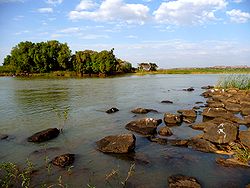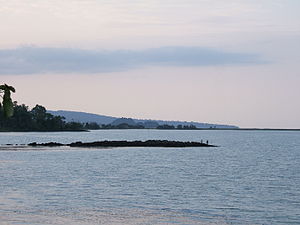
Lake Tana
Background to the schools Wikipedia
This selection is made for schools by a children's charity read more. Sponsor a child to make a real difference.
Lake Tana (also spelled T'ana, Amharic: ጣና ሐይቅ Ṭānā Hāyḳ,"Lake Tana," an older variant is Tsana, Ge'ez ጻና Ṣānā; sometimes called " Dembiya" after the region to the north of the lake) is the source of the Blue Nile and is the largest lake in Ethiopia. Located in the north-western Ethiopian highlands, according to the Statistical Abstract of Ethiopia for 1967/68, the lake is approximately 84 kilometers long and 66 kilometers wide, with a maximum depth of 15 meters, and an elevation of 1,840 meters. Lake Tana is fed by the Lesser Abay, Reb and Gumara Rivers and its surface area ranges from 3,000 to 3,500 km² depending on season and rainfall. The lake level has been regulated since the construction of the control weir where the lake discharges into the Blue Nile, which regulates the flow to the Tis Abbai falls and hydro-power station.
Overview
The lake has a number of islands, whose numbers vary depending on the level of the lake; it has fallen about 6 feet in the last 400 years. According to Manoel de Almeida (who was a Portuguese missionary in the early 17th century), there were 21 islands, seven to eight of which had monasteries on them "formerly large, but now much diminished." When James Bruce visited the area in the later 18th century, he noted that the locals counted 45 inhabited islands, but stated he believed that "the number may be about eleven." A more modern geographer named 37 islands, of which he believed 19 have or had monasteries or churches on them.
Remains of ancient Ethiopian emperors and treasures of the Ethiopian Church are kept in the isolated island monasteries (including Kebran Gabriel, Ura Kidane Mehret, Narga Selassie, Daga Estifanos, Medhane Alem of Rema, Kota Maryam and Mertola Maryam). On the island of Tana Qirqos is a rock shown to Paul B. Henze, on which he was told the Virgin Mary had rested on her journey back from Egypt; he was also told that Frumentius, who introduced Christianity to Ethiopia, is "allegedly buried on Tana Cherqos." The body of Yekuno Amlak is interred in the monastery of St. Stephen on Daga Island; other Emperors whose tombs are on Daga include Dawit I, Zara Yaqob, Za Dengel and Fasilides. Other important islands in Lake Tana include Dek, Mitraha, Gelila Zakarias, Halimun, and Briguida.
The monasteries are believed to rest on earlier religious sites and include the fourteenth century Debre Maryam, the eighteenth century Narga Selassie, Tana Qirqos (said to have housed the Ark of the Covenant before it was moved to Axum), and Ura Kidane Mecet, known for its regalia. A ferry service links Bahir Dar with Gorgora via Dek Island and various lake shore villages.
Lake Tana supports a notable fishing industry; according to the Ethiopian Department of Fisheries and Aquaculture, 1,454 tonnes of fish are landed each year at Bahir Dar, which the department estimates is 15% of its sustainable amount.





